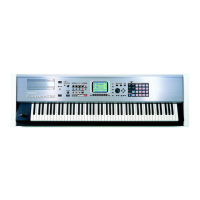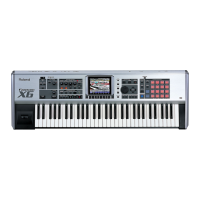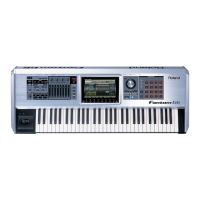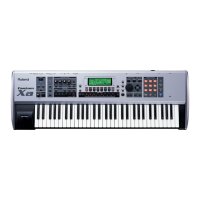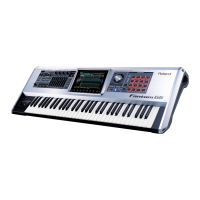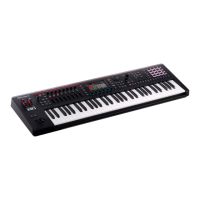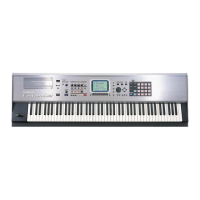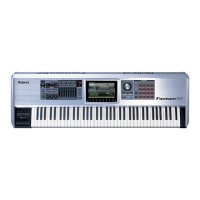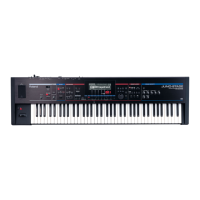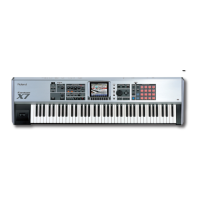
Do you have a question about the Roland Fantom-X and is the answer not in the manual?
| Polyphony | 128 voices |
|---|---|
| Sampling | Yes |
| User Patches | 256 |
| User Rhythm Sets | 32 |
| Arpeggiator | Yes |
| Keyboard | 61 keys (Fantom-X6), 76 keys (Fantom-X7), 88 keys (Fantom-X8) |
| Wave Memory | 128 MB (16-bit linear equivalent) |
| Display | 320 x 240 dots backlit graphic LCD |
| Effects | Multi-effects, reverb, chorus |
| Sequencer | 16 tracks |
| Sample Memory | 32 MB standard (expandable to 544 MB) |
| Expansion | 4 SRX expansion slots |
| Outputs | L/Mono, R, Headphones |
| Inputs | Mic/Line input |
| Connectors | MIDI In/Out/Thru, USB |
| Power Supply | AC 117 V, AC 230 V |
| Preset Patches | 1, 024 |
| Preset Rhythm Sets | 9 (GM2) |
| Patterns | 100 |
| Storage | SmartMedia card (up to 128 MB), USB |
Explains the booklet's purpose, content, and how it helps master the Fantom-X.
Explains the meaning of icons used for notes, tips, and warnings.
Introduces fundamental MIDI sequencing concepts for novice users.
Explains how the Fantom-X captures and reproduces MIDI data.
Describes the 16 pathways for MIDI data flow between devices.
Details the structure of performances, including parts and their settings.
Describes how individual sounds are defined and controlled within a performance.
Outlines the various components and settings that make up a performance.
Describes the process of playing and capturing music live.
Mentions the method of manually entering notes for recording.
Explains how songs are managed and loaded into the device's memory.
Provides steps to remove the default demo song before recording.
Instructions to disable the automatic loading of the demo song.
Details the two primary modes for initiating song creation.
Describes the buttons used for controlling recording and playback.
A fast-track tutorial for performing basic recording steps.
Details the various parameters for setting up a recording session.
Explains the Mix and Replace recording modes.
Explains the count-in options for recording.
Explains how to record sections repeatedly for practice or layering.
How to adjust the song's tempo using the dedicated TEMPO knob.
How to practice playing parts without actual recording.
How to erase recorded material in realtime during playback.
How to record rhythm patterns into a song track.
Setting up automatic punch-in and punch-out points for re-recording.
Performing punch-in and punch-out manually.
Detailed steps for programming tracks to play patterns.
Details on the readouts providing song status and location.
How to view detailed MIDI data for individual tracks.
How to assign a name to a song for identification.
How to set and manage locate points for song navigation.
Method for setting locate positions using the VALUE dial.
Alternative method for setting locate points using dedicated buttons.
Configuring loop playback for specific song sections.
Choosing a preset or saved performance as a song's basis.
How to navigate and select items within the mixer screens.
How to silence individual parts using pads or buttons.
Setting up realtime controllers for song parts.
Table layout screens for viewing and editing part parameters.
Choosing sounds (patches or rhythm sets) for song parts.
Adjusting various parameters that affect each part's sound.
Details of the Level and Pan screen parameters.
Details of the Output Assign and Effect routing parameters.
Details parameters for external MIDI channel control.
Details parameters for filtering MIDI messages.
Example of setting up effect routing to match Patch mode.
Details about the Fantom-X song file format and contents.
Technical specifications of Fantom-X song files, including the .svq extension.
Explanation of the Standard MIDI File (SMF) format.
Step-by-step guide to saving songs in SMF format.
Changing the sounds of recorded parts after initial recording.
Overview of tools for refining recorded MIDI data.
Common parameters used across various editing tools.
Selecting specific notes or data for quantization.
Explains the grid quantizing method for timing correction.
Using built-in groove templates to shape recorded notes.
Shifting the pitch of recorded notes up or down.
Separating data from multiple MIDI channels into different tracks.
Describes the layout and components of the Microscope editing screen.
How to edit individual MIDI events using the Microscope screen.
Using beat loops by assigning them to pads or keys.
Accessing the song list via the Save/Load menu.
Loading specific tracks or patterns into the current song.
Previewing songs from the song list without loading them.
